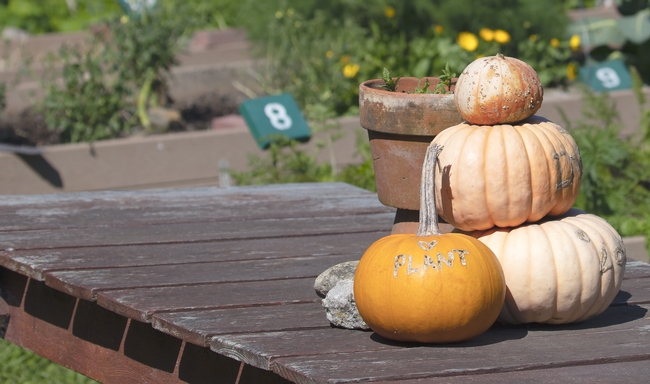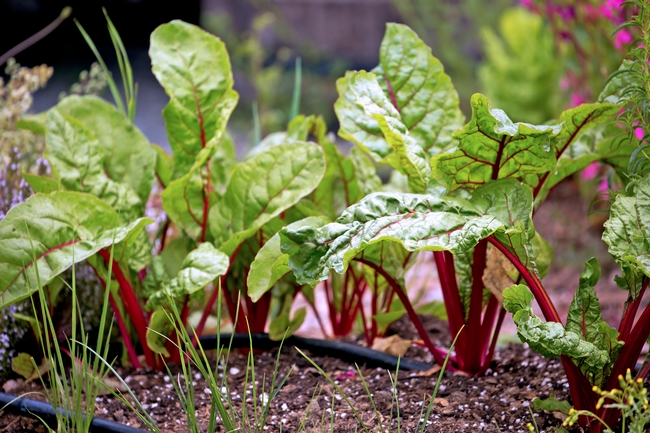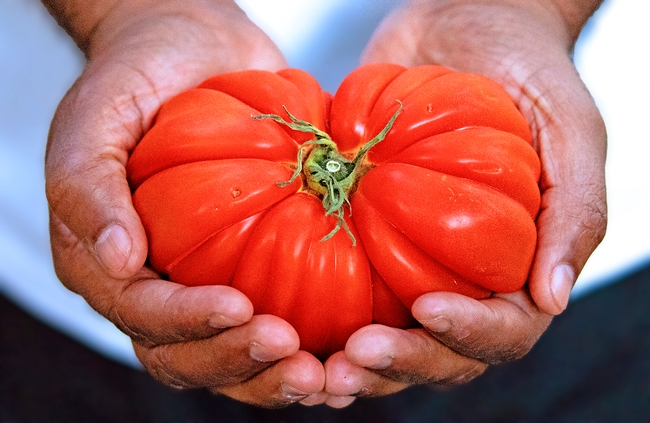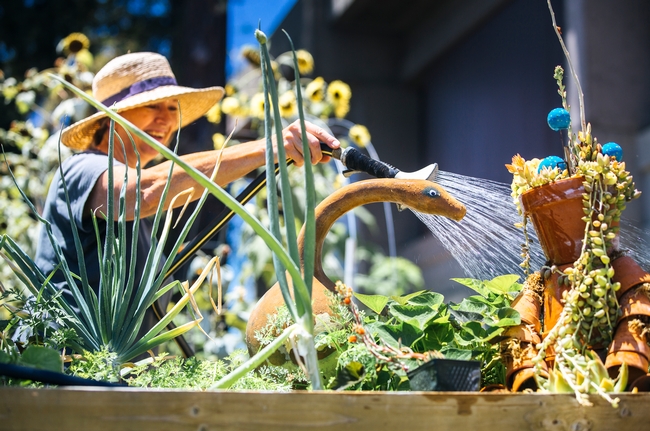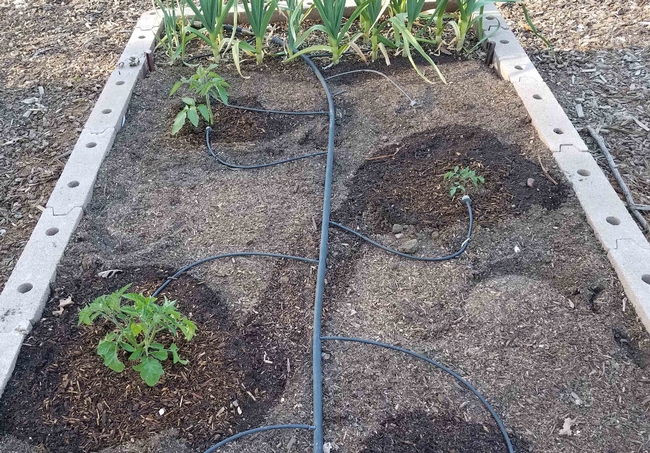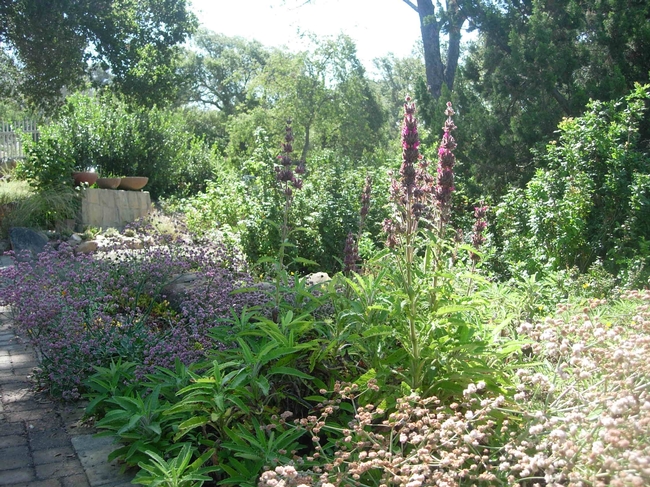In the News
UC Master Gardeners of Imperial County grow from Mexican, Latino roots
First program of its kind in area establishes free seed library, community garden
One of the many things that make University of California Cooperative Extension in Imperial County unique is its close proximity to the U.S.-Mexico border. Its geographic location, with a border town called “La Frontera” by locals, infuses the UC Master Gardener Program in this area with intercultural knowledge.
In 2022, UCCE launched its first UC Master Gardener Program in the county and has maintained a cohort of 20 participants since then. Kristian Salgado, the program's first coordinator, said the volunteers offer a range of skills to the gardening community.
“The clientele that our volunteers serve tend to be individuals who have gained their gardening knowledge and experience from tending to plants in their homeland of Mexico,” said Salgado. The volunteer UC Master Gardeners of Imperial County reflect the region's predominantly Latino demographic, making it easier for volunteers to connect with their clientele.
“Nopales, chiles, citrus…residents in this region know how to take care of these plants. They've done it all their life. But when you have a program like the UC Master Gardener Program, you can use science to explain why their practices worked all these years,” said Salgado.
According to Salgado, the UC Master Gardener Program can be perceived as too academic for some residents. “It's not a bad thing, but I had to digest the information myself, even the UC Master Gardeners, and figure out how to deliver it in a way that was relevant to everyone,” she added.
As a starting point, Salgado used English and Spanish materials from neighboring counties like “A Garden of Words/Un jardín de palabras”, developed by the UC Master Gardener Program of Los Angeles County.
One method that helped engage volunteers and residents during classes was the use of culturally significant seeds like chiltepin peppers – seeds that Salgado deems a “must-have” if you are a gardener of Mexican heritage.
“When we focused on plant propagation, the volunteers that I worked with agreed that we should propagate plants that our residents were familiar with and use in their everyday cooking,” Salgado explained.
This same approach was employed at the free seed library and demonstration garden – both established and maintained by the UC Master Gardener volunteers at the City of Imperial Public Library. During the warm season you can find Roselle (Hibiscus sabdariffa L.), known to make agua de jamaica, in the seed library – something you won't easily find in grocery stores. In the demonstration garden during the summer, you'll notice a variety of peppers such as chile güero, jalapeño, serrano and habanero.
As the UC Master Gardener coordinator for Imperial County for the last two years, Salgado has focused her leadership on establishing a program that would generate opportunities for UC Master Gardener volunteers to create projects that are reflective of their interests, align with the program's mission and serve all residents in the county. The demonstration garden, which is the first community garden established in the city of Imperial, is an outcome of Salgado's vision.
UC Master Gardener Program reflects, connects community
Eliza Barajas, UC Master Gardener of Imperial County, who works at the library during the week and has witnessed the impact of the garden, said it gives her a sense of pride. “I moved to the [Imperial] Valley a year ago and I was looking for a way to connect with the community. I couldn't have asked for a better program to do that, and I'm so proud to say that I'm a part of the very first cohort in Imperial County,” Barajas shared.
Salgado praised Barajas for her enthusiasm in the program and noted her excellent ability to speak Spanish. “I love the way Eliza flows from English to Spanish. It's effortless! And it comes in handy when we're doing community events and need to cater to our Spanish and English speakers,” said Salgado.
Since the program came to fruition, Salgado has played a pivotal role in the program's progress. Reflecting on why she accepted the role of UC Master Gardener coordinator for Imperial County, Salgado said that the role was a culmination of everything she studied in school and cares deeply about.
While attending California State Polytechnic University, Humboldt, Salgado earned a master's degree in social science focused on the environment and community. She studied the intersections of food insecurity, the agricultural industry and health inequities, and how they specifically impact the Latino community.
Growing up and currently living in Calexico, Salgado questions why her community is food insecure. “Imperial is the ‘salad bowl' of the nation. We export a variety of fresh fruit and veggies all year long. How is it that our community doesn't have enough access to the healthy food it produces?” she asked.
Food security is one concern that Salgado envisions the UC Master Gardener Program addressing through its seed library, community garden and gardening classes.
Following graduate school, Salgado moved back home and joined former classmate and UCCE colleague, Chris Wong, in establishing the first farmer's market in Calexico in 2013. Wong encouraged Salgado to apply her new knowledge and skills at UCCE Imperial County, where she began working as a climate-smart agriculture community education specialist in 2019, supporting growers with grant writing.
“I realized early on that there was a lot of divestment in the community, and I didn't understand why,” she said, adding that she's still working to understand. Salgado's mother-in-law also continuously challenged her to think bigger. “My mom-in-law comes from the Chicano Movement. She's guided me into thinking more critically about the issues we face in our community and as Latinos.”
In September, Salgado began in a new role as the regional operations specialist for the UC Master Gardener Program statewide office, covering the Bay Area to Southern California regions. Salgado hopes to develop useful tools and resources to support coordinators' professional development, while integrating programmatic best practices centered on diversity, equity, inclusion and justice.
“The UC Master Gardeners are full of knowledge, and my education was motivated by identifying how Latinos can get a seat at the table. UC Master Gardeners easily become trusted sources in the community, and for Imperial County, this is how they get a seat at the table,” said Salgado.
October Garden Tip - Hello Fall!
October is here, and with it comes a mix of warm days and cool nights. As the seasons change, prepare your garden for the challenges and opportunities that lie ahead. Here are some friendly and supportive tips to help your garden thrive this October, no matter where you are in the Golden State!
1. Care for Your Lawn
October is a great time to give your lawn some extra attention. Use an organic, high-nitrogen fertilizer to promote healthy growth. Remove any weeds and reseed any bald spots. Water well until the winter rains arrive. The Statewide Integrated Pest Management Program has a helpful lawn fertilizing guide.
2. Sow Wildflower Seeds
Why not create a beautiful wildflower garden this month? Wait until temperatures are consistently cool late in the month, then choose a sunny spot and prepare the soil by removing weeds and grasses. To complete site prep, mix organic compost into the soil to help retain moisture. Scatter your wildflower seeds evenly, lightly rake them in, and add a thin layer of compost on top. Water well and watch your garden bloom next spring!
3. Plant Cool-Season Crops
Cooler temperatures are ideal for many vegetable crops. Consider planting transplants of broccoli, cauliflower, and kohlrabi, which will be ready by February. Leafy greens like Swiss chard, spinach, and kale grow quickly and can be harvested by December. You can also direct-seed peas, turnips, carrots, radishes, and beets now for an early winter harvest.
4. Plant Garlic
Garlic lovers, rejoice! October is the perfect time to plant your garlic bulbs. Choose a sunny spot with rich, well-drained soil, and protect them from gophers if needed. Garlic takes about 6 to 8 months from planting to harvest, so plan accordingly.
5. Maintain Winter Soil Health
Even areas of your garden that aren't actively planted can benefit from some attention this month. Consider using cover crops, like fava beans, which enrich the soil with nitrogen. Adding organic mulches such as grass clippings, leaves, wood chips, or straw will help retain moisture, moderate soil temperature, and prevent weeds from sprouting.
6. Enjoy Persimmon Season
October brings delicious Fuyu and Hachiya persimmons! Fuyu persimmons can be eaten raw when firm, while Hachiya ones are best enjoyed when soft and jelly-like. Protect your trees from birds by using bird netting. Use pruners when harvesting fruit, and always avoid ripping or pulling persimmon from branches.
7. Keep Watering
Despite cooler temperatures, warm days may still occur. Continue to water your garden until the rains begin. Check your soil moisture by digging down a bit—if it holds shape when squeezed, it's just right!
8. Inspect Your Watering System
If you have an automatic watering system, now is a great time to check for leaks and blockages. Ensure your timer is working correctly and reprogram it for the cooler weather. If you don't have a system, consider installing one—it can save you time and water!
9. Harvest Pomegranates Wisely
When it comes to harvesting pomegranates, timing is crucial. Look for a deepening color and a metallic sound when tapped. Clip the stem close to the fruit instead of pulling to avoid damage. Remember, pomegranates don't ripen further after harvest, so pick them at the right time!
10. Plant Shrubs for the Future
Fall is a great time to plant shrubs. California natives are especially low-maintenance and can establish strong root systems before summer stress hits. Consider the conditions of your site and the purpose of the plant when selecting new additions to your garden.
October is a busy and exciting time in the garden! By following these tips, you'll not only keep your garden thriving through the cooler months but also set yourself up for a successful spring. Embrace the changes of the season and enjoy all the beauty and bounty your garden has to offer! Happy gardening!
Ask your local UC Master Gardener Program.
Have a gardening question? UC Master Gardener volunteers are available to help. Click here to Find a Program and connect with your local UC Master Gardener Program. You will be redirected to your local county website and contact information. UC Master Gardener volunteers are available to help answer questions for FREE. Happy gardening!
September Gardening Tips - Summer is coming to an end, it's time for Fall!
September is a crucial month for gardeners across California, where the state's diverse climates offer a range of opportunities. Whether you're dealing with the cool coastal air or the lingering heat of the inland valleys, this is the time to prepare your garden for the coming seasons. Here's a list of tips to help your garden thrive this September, no matter where you are in the Golden State.
1. Plant Fall Crops
As your summer crops finish, it's time to get your fall and winter garden going. In many parts of California, it's time to clear out the old plants and consider enriching the soil with compost, and sow cool-season veggies like carrots, chard, peas, beets, and radishes. Transplant broccoli, cabbage, leeks, brussels sprouts, cauliflower, and kale for a hearty winter harvest.
2. Install Raised Beds
Have you considered a food garden but haven't taken the first steps? Cool season crops will be in the ground soon, and while you don't have to grow edible plants in a raised bed, these structures are helpful in maximizing plant growing space and allow gardeners to optimize soil for growing vegetables. Pre-fabricated options and step-by-step DIY guides are available.
3. Shop for Spring-Blooming Bulbs
September is prime time to pick up bulbs for a colorful spring. Daffodils, crocus, freesia, anemones, Dutch iris, and ranunculus are all widely available now, so grab them while you can. Plant them this fall, and your garden will be bursting with color come spring.
4. Plan for New Perennial Plantings
With winter rains on the horizon, now is a great time to plan for new trees, shrubs, perennials, and ornamental grasses in your garden. Planting later in the fall is ideal, so start making decisions and mapping out new additions or changes now. Native plants are especially suited for fall planting—they'll have plenty of time to establish strong roots before spring.
5. Continue Watering Thoroughly
Even though the days are getting shorter, September can still bring plenty of heat. Keep a close eye on your garden's water needs, particularly during heat waves. Make sure your plants, especially shrubs, stay hydrated to reduce stress.
6. Start Sweet Peas
Sweet peas make a lovely addition to any garden. Start planting them in late September and continue sowing seeds weekly throughout the next month. This will give you a steady supply of blooms through winter and spring.
7. Care for Shrubs
As the temperatures start to drop, many shrubs begin to wind down. Keep them watered to help them cope with the lingering summer heat. California natives might need less water as many are dormant late summer through fall.
8. Tend to Your Roses
September is when many roses, especially in Southern California, experience a “second spring.” If you pruned your roses in summer, you'll likely see new growth and developing buds now. Get ready for a beautiful bloom in October and November.
9. Fertilize Fruit Trees
With harvest wrapping up or complete, it's time to apply late summer fertilizer. Fertilizers should be applied around the drip line of the tree, away from the trunk. Be sure to water after fertilizing so plant roots will pick up the nutrients.
10. Start Seed Saving
If you had some favorite vegetables this summer, why not save their seeds for you to use next year? Beans, peppers, lettuce, and tomatoes are easy to save following simple guidelines. Store fully dried seeds in airtight containers in a cool, dark place until spring.
September is a busy time in the garden, offering plenty of chances to prepare for fall and get a jump start on spring. By following these tips, you'll keep your garden thriving through the cooler months and set yourself up for success next year.
Ask your local UC Master Gardener Program.
Have a gardening question? UC Master Gardener volunteers are available to help. Click here to Find a Program and connect with your local UC Master Gardener Program. You will be redirected to your local county website and contact information. UC Master Gardener volunteers are available to help answer questions for FREE. Happy gardening!
August Garden Tips - Keeping our Summer Gardens Going
Summer is flying by and somehow it is already August, kids are going back to school and we are starting to dream of fall gardens. Our August gardens still need our love and care though. Here are some tips to keep your August garden going:
- Morning Watering: Water your plants early in the morning while it's still cool. This practice reduces evaporation and moisture loss, ensuring plants receive the water they need to thrive. Additionally, morning watering allows the plants to dry off during the day, reducing the risk of fungal diseases.
- Keep Young Plants Watered: Monitor fruit and shade trees, shrubs, and perennials planted within the last year closely. Young roots are especially vulnerable to drying out during their first summer. Check soil moisture regularly to prevent dehydration.
- Monitor Vegetable Plants: Wilting or drooping leaves on vegetable plants during hot afternoons do not always indicate dry soil. Check the soil moisture by digging down and water only when necessary to avoid overwatering.
- Prune Fruit Trees: After harvesting fruit, prune the new summer growth of your fruit trees. This is a great way to properly manage growth, shape the tree, and an opportunity to remove dead or diseased wood. The pruning will also help sunlight penetrate the interior wood, encouraging the development of fruiting wood for the next season.
- Regular Harvesting: Harvest beans, cucumbers, squash, and tomatoes at least every other day. Regular harvesting promotes further production, ensuring a continuous and bountiful supply of summer vegetables.
- Protect Tree Trunks: Apply a coat of light-colored interior latex paint to tree trunks to prevent sunscald, a condition where the bark on the south or southwest side of a tree becomes sunburned. The light-colored paint reflects sunlight, helping to keep the bark temperature more consistent and preventing damage from the sun. This is particularly important for young trees, as they have not yet developed a thick bark to protect them from the sun's rays.
- Weed Control: Continue pulling weeds before they form seed heads and scatter their seeds. Consistent weeding now will reduce weed problems later in the season.
- Prune Berry Canes: After berry harvest, prune the canes that have finished bearing fruit. Different berries require specific pruning techniques, so know your variety and prune accordingly.
- Tomato Care: Watch for pests and diseases on your tomato plants. Maintain a consistent watering schedule to prevent issues like blossom end rot and monitor for destructive pests like the tomato hornworm caterpillar.
- Care for Roses: Hose off the foliage of roses frequently to reduce the likelihood of powdery mildew and discourage spider mites. Contrary to popular belief, this practice benefits the plants' health. Complete this task early in the day to allow leaves to dry before evening, it's important to ensure proper air circulation and avoid prolonged wet conditions to prevent other fungal issues.
- Planting Warm-Season Vegetables: July is still an excellent time to plant warm-season vegetables such as beans, cucumbers, eggplants, okra, peppers, squash, and tomatoes. These vegetables thrive in warm weather and can be harvested in late summer or early fall. Ensure they are well-watered to support their growth.
- Plan Cool-Season Vegetable Garden: It's time to start planning our Fall gardens. This is a time to plant cool season crops like leafy greens (kale, chard, mustard greens, arugula, lettuce, spinach, bok choi and more), brassicas (broccoli, cabbage, cauliflower, romanesco, Brussels, kohlrabi), root veggies (radish, beets, turnips, carrots) plus peas, garlic, onions, and leeks.
Keep your August gardens going with these tips and enjoy dreaming of the cooler weather coming soon!
Ask your local UC Master Gardener Program.
Have a gardening question? UC Master Gardener volunteers are available to help. Click here to Find a program and connect with your local UC Master Gardener Program. You will be redirected to your local county website and contact information. UC Master Gardener volunteers are available to help answer questions for FREE. Happy gardening!
Water Management for California Home Gardeners
Water is essential for any garden, but it's crucial to use water wisely in a place like California, where droughts are common. Effective water management can help home gardeners keep their plants healthy while conserving this precious resource. Thoughtful water management uses resources efficiently and sustainably to meet current and future needs. It involves planning, developing, distributing, and managing the optimum use of water to ensure plants survive and look good. By conserving water, home gardeners contribute to the preservation of local ecosystems and the sustainability of the environment.
Plant Water Use
Understanding how much water your plants need is the first step in effective water management. Different plants have different water requirements. For instance, succulents and cacti need less water than vegetables or fruit trees. It's important to group plants with similar water needs together. This way, you can avoid overwatering or underwatering specific plants. You can learn about plant water needs from plant labels, gardening books, or by reaching out to your local UC Master Gardener volunteers for support. Additionally, observing your plants and learning their symptoms of water stress, such as wilting or drooping leaves, can also help inform water management.
Watering Systems
Several watering systems can help manage water use in a garden. Drip irrigation is one of the most efficient methods. It delivers water directly to the roots of plants, minimizing evaporation and runoff. Soaker hoses, porous hoses that seep water along their length, are another good option for watering garden beds. Traditional sprinklers can be used, but they are less efficient because they tend to waste water through evaporation and runoff. Newer, more advanced systems include weather-based controllers that adjust watering schedules based on weather conditions, ensuring plants get the right amount of water without waste.
Irrigation Best Practices
Take a proactive role in water conservation by adopting best practices for irrigation. Watering early in the morning or late in the evening reduces evaporation, ensuring more water reaches the plants. Mulching the garden helps retain soil moisture and reduces the need for frequent watering. Regularly checking for leaks in the irrigation system and repairing them promptly can prevent water loss. Adjusting the watering schedule based on the season and weather conditions is also essential. During cooler months or after rainfall, plants need less water; in the hot summer, they may need more frequent watering.
Use Drought Tolerant Plants
One of the most environmentally responsible ways to conserve water in a garden is to use drought-tolerant and/or native plants. Drought tolerance reflects the ability of a plant to withstand less than optimal water supplies due to adaptive or avoidance mechanisms. While many native plants possess drought-tolerant traits and require less supplemental irrigation once established, many non-native plants Mediterranean-adapted plants also thrive on relatively lower water. It is important to remember that these plants require water regularly until their root structure is well established in landscape soil. Maintaining these plants with deep and infrequent irrigation once established is a great way to reduce landscape water use. By incorporating these plants into your garden, you're also providing habitat for local wildlife. This creates a beautiful, low-maintenance landscape that thrives with less irrigation.
Best Practices for Keeping Plants Alive During a Drought
During a drought or under water restrictions, it's essential to prioritize how you use water in the garden. Focus on watering the most valuable and vulnerable plants first, such as shade trees and young trees. Slow, deep watering is more effective than frequent shallow watering. This involves watering to a depth slightly below the plant root zone which encourages roots to grow deeper into the soil, making plants more drought-tolerant. Reducing the size of your lawn or replacing it with drought-tolerant ground covers can also save significant amounts of water. Additionally, using shade cloth or temporary shading can help reduce water loss by protecting plants from intense sunlight.
By understanding plant water use, choosing suitable watering systems, adopting best irrigation practices, using drought-tolerant plants, and implementing drought survival strategies, California home gardeners can maintain a healthy and beautiful garden while conserving water. Water management is beneficial for your garden and the environment, and is an especially important practice for Californians. Your conscious efforts in water management contribute to the sustainability of our environment.
To learn more please reach out to your local UC Master Gardeners Program.










